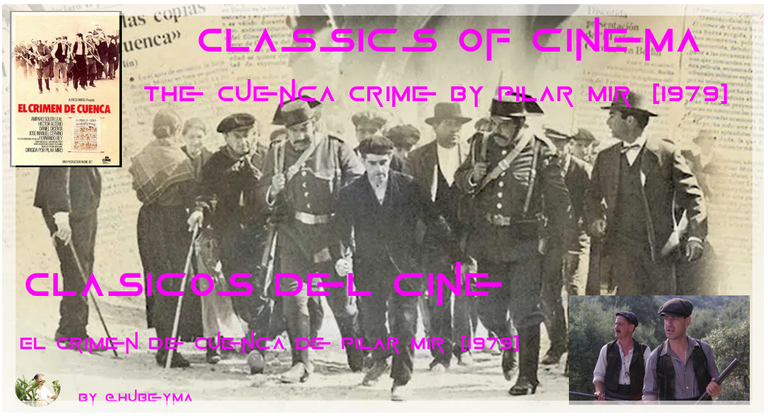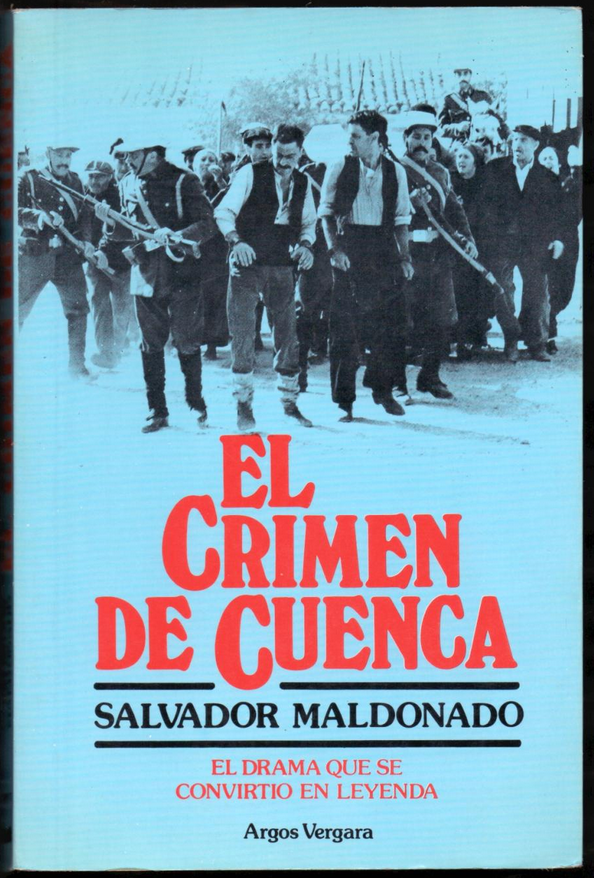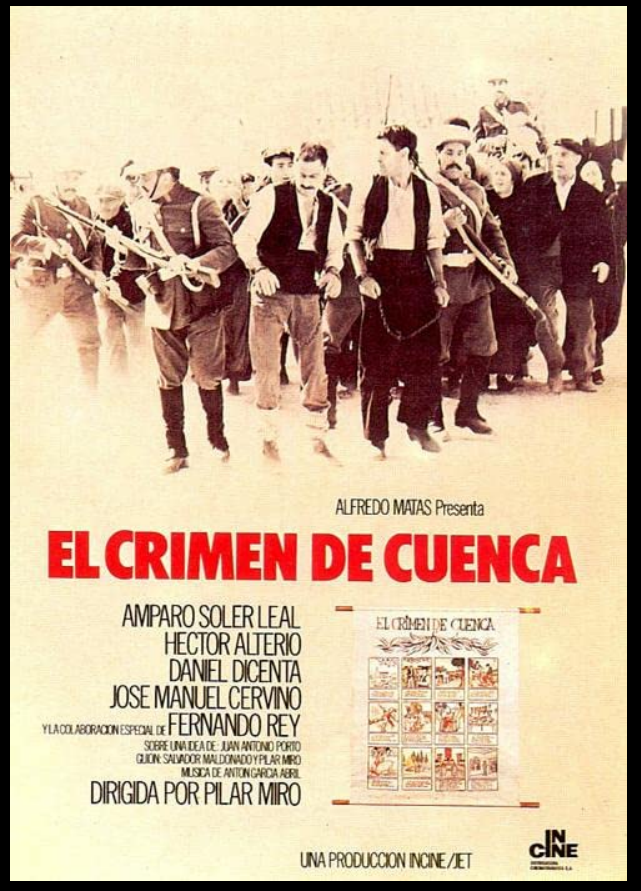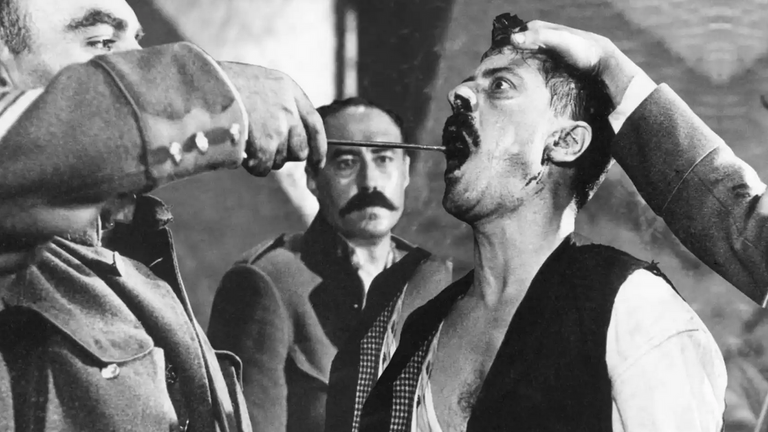|REVIEW| Classics of cinema: The Cuenca Crime by Pilar Miró (1979). / |RESEÑA| Clásicos del cine: El Crimen de Cuenca de Pilar Miró (1979).

I continue, with this review of films that have left an indelible mark on my spirit as a lover of cinema, of good cinema to be clear, sharing with all the #hivers ciéfilos of this beautiful Community some beautiful films that have left their indelible mark on the history of cinema.
Most of the films I saw in my early youth -many times over the years I have gone back to them- and I have surprised myself with the memories that I still kept intact in my mind, in spite of the years that have passed.
Scenes of which I remember as if time had never passed. Perhaps because each one of us has gone through, in our youth, that stage in which problems do not exist or are of minimal importance. The passing of time has forced us to concentrate our attention on more urgent problems, pushing the others into the background.
Today I would like to tell you about a film that impressed me vividly in the eighties when I saw it for the first time. Not many years ago I saw it again with the same enthusiasm as the first time.
I am talking about The Cuenca Crime, a truly monumental cinematographic work by Pilar Miró.
The plot of the film is based on a true story: in 1913 the shepherds Gregorio Valero Contreras and León Sánchez Gascón, friends and neighbours of Osa de la Vega (Cuenca) are arrested as responsible for the death of José María Grimaldos López, nicknamed "El Cepa", a shepherd and former teammate (in reality he disappeared of his own free will).
The people together with the wife of the alleged victim accuse them by gathering false evidence against them and the two men end up confessing to the crime after numerous tortures under the promise that by doing so they will avoid the death penalty in exchange for an eighteen-year prison sentence. So much for the police chronicle.

In the best style of the stories sung by medieval minstrels, in this case it is a blind man who relates - at the beginning of the film - in one of his romances the events that occurred some years before in the province of Cuenca.
The plot then begins to unfold with the disappearance of the presumed victim when his mother, Juana López, goes out to look for him, hoping to find him on the banks of the river where he had said he was going to bathe.
A few days later (and this is where the film's humanist and critical touches towards a society with rural roots, deeply ignored and tied to age-old convictions really begin) Juana and her husband, Anselmo, go to the Duty Court in Belmonte (Cuenca) to report the disappearance of their son, even assuring the judge that he has probably been murdered because he had gone to take a bath and had not returned. Ignorance and superstition blend admirably in a context of social backwardness and mutual distrust.

Some note that the last time they saw him was in the company of two braceros, Gregoria and León, who worked for a local landowner.
The parents go to see the braceros to ask them for explanations and everything ends in an altercation, as it is not the first time that the young man has done the same thing.
Hatreds, old grudges and mistrust combine so that the two men are accused of the crime, overwhelmed by the evidence of criminal records against them as both had attacked one of the collectors of the deputy Contreras during the last elections, although they were later acquitted.
Re-elected deputy Contreras convinces the judge to issue an arrest warrant for the two suspects who are arrested and subjected to inhuman torture to make them confess, and even turn them against each other, promising leniency to the one who gives up his partner.
The investigations continue in the area around the river in an unsuccessful attempt to find the body.
After an alleged accusation of where El Cepa might be buried, both are taken to the cemetery and, faced with a crowd that verbally attacks them and tries to lynch them, they proceed to dig up the remains of a grave that, in the end, are revealed not to be those of El Cepa.
Dolores, the wife of one of the detainees, is forced to enter into the conspiracy and testify falsely against him, under the threat that if she does not do so, she will see her little daughter starve to death.
In the end, despite the lack of evidence and the torture and humiliation received, both are sentenced to eighteen years in prison.
The minstrel, in this case the blind man, closes the story of their romance of the -apparent- bloody murder that concludes with the criminals in the prisons of Cartagena and Valencia.
Ten years later, the first to be released for good behaviour is Gregorio, who returns home but does not greet his wife, who unjustly denounced him, although with the threat of having his daughter taken away from him.
An apparently insignificant event begins to shed light on the mystery. Don Rufino, the parish priest, receives a letter from Mira de la Sierra and shows it to the deputy and strong man of the town Contreras, where he is asked from another parish for the birth certificate of José María Grimaldos López, nicknamed "El Cepa" - the presumed murdered - and the death certificate of Juana, his mother, because Grimaldos wants to get married.
Trying to discover (or hide) the truth Contreras grabs the letter from the parish priest and asks him to forget about it. However, it is too late to hide the secret because the parish priest had previously confessed it to more than one person in the parish.
Meanwhile, the Guardia Civil went to look for Cepa, who was preparing for the wedding party (he already had three children by the woman he was living with) and also went to look for Gregorio and León, one to make him testify and the other to free him.
On 10 July 1926, the Supreme Court issued the definitive sentence reviewing the case, declaring the conviction null and void and proclaiming the innocence of Gregorio Valero and León Sánchez.
But the best and most moving part of the film is the end of the film when the three are on their way to the courthouse and Cepa finds himself halfway between Gregorio and León. They look at each other for a moment and run to embrace, while Cepa - in the middle - trembles in terror and thinks that they want to attack him for the misfortunes and unjust accusations he has suffered.

Amparo Soler Leal as Varona, Gregorio's wife
Héctor Alterio as Judge Emilio Isasa
Daniel Dicenta as Gregorio Valero
José Manuel Cervino as León Sánchez
Mary Carrillo as Juana, mother of José María
Guillermo Montesinos as José María Grimaldos "El Cepa" (José María Grimaldos "El Cepa")
Fernando Rey as Member of Parliament Francisco Martínez de Contreras
Mercedes Sampietro as Alejandra, servant of Judge Isasa
Assumpta Serna as Manuela, José María's wife

The film is a harsh indictment of torture carried out by members of the Guardia Civil, and it is implied that it is a practice often used by the Guardia Civil.
The thoroughness with which the torture is described led representatives of the Union of the Democratic Centre (UCD) to request its abduction and handing over to the military headquarters.
Finally, and after its own director Pilar Miró was subjected to a military trial, the film was released in mid-August 1981, carrying on its shoulders the unanimous recognition of the world's film critics and the sad recognition of being the only Spanish film banned during democracy, after the disappearance of censorship in 1977.


Sigo, con esta reseña de películas que han dejado una marca indeleble en mi espíritu como amante del cine, del buen cine para ser claros, compartiendo con todos los #hivers ciéfilos de esta hermosa Comunidad algunos películas bellísimas que han dejado su marca indeleble en la historia del cine.
Películas vistas en mi primera juventud la gran mayoría -muchas veces después con el correr de los años las he vuelto- y me he sorprendido a mi mismo con los recuerdos que todavía conservaba intactos en mi mente, a pesar de los años transcurridos.
Escenas de las cuáles me recuerdo como si el tiempo no hubiera pasado. Tal vez porque cada uno de nosotros ha transitado, en su juventud, esa etapa en la cuál los problemas no existen o son de mínima envergadura. El pasar del tiempo nos ha obligado a concentrar nuestra atención en problemas más urgentes haciendo pasar los restantes a un segundo plano.
Hoy les quiero comentar una película que me impresionó vidamente en los años ochenta cuando la ví por primera vez. Hace no muchos años la volví a ver con el mismo entusiasmo de la primera vez.
Estoy hablando de El Crimen de Cuenca, una obra cinematográfica verdaderamente monumental de Pilar Miró.
El argumento de la película está basado en una historia rea: en 1913 los pastores Gregorio Valero Contreras y León Sánchez Gascón, amigos y vecinos de Osa de la Vega (Cuenca) son detenidos como responsables de la muerte de José María Grimaldos López, apodado "El Cepa" pastor y antiguo compañero de equipo (en realidad desaparecido por su propia voluntad).
El pueblo junto a la mujer de la presunta víctima los acusa reuniendo pruebas falsas contra ellos y los dos hombres terminan por confesar el crimen tras numerosas torturas bajo la promesa de que así haciéndolo evitarán la pena capital en cambio de la condena a dieciocho años de prisión. Hasta aquí la crónica policial.

Al mejor estilo de las historias cantadas por los juglares medievales en este caso es un ciego que relata -iniciando la película- en uno de sus romances los sucesos ocurridos unos años antes en la provincia de Cuenca.
De seguido la trama comienza a desarrollarse con la desaparición de la presunta víctima cuando su madre cuando Juana López sale a buscarlo esperando encontrarlo a orillas del río donde había dicho que iba a bañarse.
Algunos días más tarde (y aquí comienzan verdaderamente los toques humanistas y críticos del film hacia una sociedad de raigambre rural, profundamente ignorada y atada a convicciones milenarias) Juana y su esposo Anselmo, van al Juzgado de Guardia de Belmonte (Cuenca) para denunciar la desaparición de su hijo, incluso aseguran ante el juez que probablem,ente haya sido asesinado porque había ido a tomar un baño y no había regresado. Ignorancia y superstición se mezclan admirablemente en un contexto de atraso social y mutua desconfianza.
Algunos advierten que la última vez que lo vieron era en compañia de dos braceros, Gregoria y León, que trabajaban para un terrateniente local.
Los padres van a ver a los braceros para pedirles explicaciones y todo termina con un altercado, ya que no es la primera vez que el joven hacía lo mismo.
Odios, viejos rencores y desconfianza se aúnan para que los dos hombres sean acusados del delito, abrumados por las pruebas de antecedentes penales en su contra ya que ambos habíanatacado a uno de los recaudadores del diputado Contreras durante las últimas elecciones, aunque luego habían sido sobreseídos.
Reelegido diputado Contreras convence al juez para emanar una orden de captura contra los dos sospechosos que son detenido y sometidos a torturas inhumanas para hacerlos confesar, e incluso los ponen a uno contra otro, prometéndoles indulgencia al que delate a su compañero.
Las pesquisas continúan en los alrededores del rio tratando de encontrar, infructuosamente, el cadáver.
Ante una presunta denuncia de donde puede estar enterrado El Cepa ambos son conducidos hasta el cementario y ante una multitud que los agrede verbalmente y trata de lincharlos proceden a desenterrar los restos de una fosa que, al final, se revelan no son los del Cepa.
Dolores, la propia mujer de uno de los detenidos, es obligada a entrar en la conspiración y declarar falsamente en su contra, bajo la amenza de que si así no lo hace verá morir de hambre a su pequeña hija.
Finalmente no obstante la falta de pruebas y las torturas y humillaciones recibidas, ambos son condenados a dieciocho años de cércel.
El juglar, en este caso el ciego, cierra la historia de su romance del -aparente-cruento asesinato que concluye con los criminales en las cárceles de Cartagena y Valencia.
Diez años más tarde el primero en recobrar la libertad por buena conducta es Gregorio que vuelvce a su casa pero no saluda a su mujer que lo delatado injustamente, aunque con la amenaza de que le quitaran a su hija.
Un hecho, aparente de poca trascendencia, comienza a echar luz sobre el misterio. Don Rufino, el párroco, recibe una carta de Mira de la Sierra y se la muestra al diputado y hombre fuerte del pueblo Contreras, donde le piden desde otra parroquia la partida de nacimiento de José María Grimaldos López, apodado "El Cepa" -el presunto asesinado- y la partida de defunción de Juana, su madre porque Grimaldos desea casarse.
Tratando de descubrir (o esconder) la verdad Contreras aferra la carta del párroco y le piede que se olvie de la misma. Sin embargo es demasiado tarde para ocultar la secreto porque el párroco lo había confidado previamente a más de uno en la parroquia.
Mientras tanto la Guardia Civil va a buscar al Cepa que se está preparando para la fiesta de casamiento (ya tiene tres hijos de la mujer con la que convive) y también va a buscar a Gregorio y León, a uno para que declare y al otro para liberarlo.
El 10 de julio de 1926 el Tribunal Supremo emite la sentencia definitiva de revisión del caso declarando la nulidad de la sentencia condenatoria y proclamando la inocencia de Gregorio Valero y León Sánchez.
Pero lo mejor y más conmovedor es el final de la película cuando los tres van camino al juzgado y el Cepa se encuentra a mitad de camino entre Gregorio y León. Ambos se miran por un instante y corren a abrazarse mientras el Cepa -en el medio- aterrado tiembla y piensa que quieren atacarlo por los infortunios y las injustas acusaciones sufridas.

Amparo Soler Leal como Varona, esposa de Gregorio
Héctor Alterio como Juez Emilio Isasa
Daniel Dicenta como Gregorio Valero
José Manuel Cervino como León Sánchez
Mary Carrillo como Juana, madre de José María
Guillermo Montesinos como José María Grimaldos «El Cepa»
Fernando Rey como Diputado Francisco Martínez de Contreras
Mercedes Sampietro como Alejandra, sirvienta del juez Isasa
Assumpta Serna como Manuela, esposa de José María

La película es un duro alegato contra la tortura llevada a cabo por miembros de la Guardia Civil y se da a entener que una práctica usada a menudo por la misma.
La minuciosidad con que son descriptas las torturas llevó a que los representantes de la Unión de Centro Democrático (UCD) solicitara su secuestro y puesta a disposición de la jefatura militar.
Finalmente y después que su propia directora Pilar Miró fuera sometida a un proceso militar, la película es estrenada a mediados de agosto de 1981, cargando sobre sus espaldas el reconocimiento unánime de la crítica cinematográfica mundial y el triste reconocimiento de ser la única película española prohibida durante la democracia, tras la desaparición de la censura en 1977.


Electronic-terrorism, voice to skull and neuro monitoring on Hive and Steem. You can ignore this, but your going to wish you didnt soon. This is happening whether you believe it or not. https://ecency.com/fyrstikken/@fairandbalanced/i-am-the-only-motherfucker-on-the-internet-pointing-to-a-direct-source-for-voice-to-skull-electronic-terrorism
https://twitter.com/belmaxhugo/status/1496225219282878465
The rewards earned on this comment will go directly to the person sharing the post on Twitter as long as they are registered with @poshtoken. Sign up at https://hiveposh.com.
Thank you for your continued support of my content @poshtoken.
What else can I say about this movie!
It's Classic, we also have the same movie genre like this in our country.
!1UP
It is true that it is a Spanish classic, but it also marked a milestone in world cinema for the concept of social denunciation that it implies.
Thank you for curating my content @ivarbjorn.
Regards.
You have received a 1UP from @ivarbjorn!
@cine-curator, @neoxag-curator, @pal-curatorAnd they will bring !PIZZA 🍕
Learn more about our delegation service to earn daily rewards. Join the family on Discord.
Thank you for curating my content @curation-cartel!